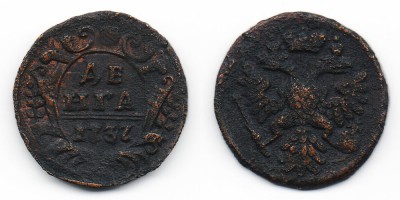As a means of payment, old European coins are simultaneously used in different states and even their names are the same or similar. Among such coins is a shilling, which began to be minted in Germany in the 14th century. England produces these monetary units from the XVI century, the Netherlands and Denmark - from the XV century.
In 1737, the Mint of Germany Clausthal, minted a silver coin 1 shilling, weighing 1.1 g. Obverse: denomination and name of the coin in a circle, below - the date of issue. Reverse: an emblem in the form of a galloping horse is depicted in a circle, the direction is to the left. Below, in an arc: the initials of the minzmeister - CPS. This, Christian Philip Shpangenberg - responsible for the coin production, weight and sample of produced coins. The emblem is surrounded by an inscription in a circle, in Latin: a new coin of Lauenburg, George II.
Another loose change that is in use in different countries is pfenning. This banknote has one root with a British penny, a Scandinavian penning, a fening of Bosnia and Herzegovina, a penny of Poland. In Germany, pfenning was minted from the 8th century.
The Mühlhausen Mint, Germany, prints in 1737 a coin from a billon, with a face value of 6 pfenning, 17 mm in size. Weight unknown. The obverse depicts the emblem of power: the orb - a ball with a cross. Below - denomination, in Roman numerals. On the left and right of the cross there is a year of release, divided by two numbers: 17 and 37.
There are no other inscriptions on the front side.
On the reverse: coat of arms, in the form of a heraldic shield, with a helmet on top, a crest and a mantle. On the emblem: the eagle symbol, located to the left. Circular depicted abbreviated inscriptions that denote the name of the country and the mint.
A copper coin, worth 3 pfenning, measuring 19 mm, which was issued in 1737, also does not know weight. The front side of the same species as 6 pfennings. The difference is in the frame of the face value of the coin with a decorative wreath. On the reverse: emblem with key, in frame, made in the form of an oval. The year of issue and inscriptions are also applied.
Another pfenning minted in 1737 the Goslar mint. This is a copper coin, in denominations of 1, weighing 2.53 g. On the obverse side of the coin: Madonna, consecrated with rays, below - the emblem of the city. On the reverse, in six lines, there are inscriptions that contain the initials of the minzmeister Heinrich Christoph Rudolf Frize, as well as the date and denomination. In a circle - inscriptions.
Showing 1 to 1 of 1 (1 Pages)
 Russian
Russian English
English Deutsch
Deutsch Spanish
Spanish Português
Português


